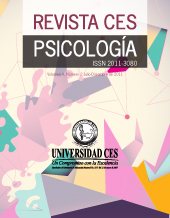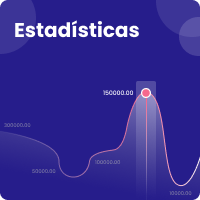Propiedades psicométricas de un Stroop emocional computarizado para evaluar vulnerabilidad cognitiva
DOI:
https://doi.org/10.21615/cesp.10.2.7Palabras clave:
Atención, Emoción, Stroop, Ansiedad, Depresión, Validez, ConfiabilidadResumen
El objetivo del presente trabajo fue diseñar y validar un instrumento computarizado de Stroop modificado con reactivos de contenido emocional, siguiendo el modelo bioinformacional. El estudio fue cuantitativo empírico analítico con diseño no experimental instrumental transversal. La muestra fue de 343 participantes (58.6% mujeres, 41.1% hombres), con edades entre 18 y 49 años (M=24.36, DE=6.49), a quienes se les registró el tiempo de respuesta ante los estímulos. Los resultados indicaron una consistencia interna favorable (α=.89), con una solución unidimensional (Interferencia) que explicaba el 63.75% de la varianza. Se concluyó que el instrumento es válido y confiable para evaluar interferencia emocional a nivel preatencional, así como facilitar las investigaciones sobre procesos atencionales y vulnerabilidad cognitiva.
Descargas
Referencias bibliográficas
Albert, K., Gau, V., Taylor, W. D., & Newhouse, P. A. (2017). Attention bias in older women with remitted depression is associated with enhanced amygdala activity and functional connectivity. Journal of Affective Disorders, 210, 49-56. doi: 10.1016/j.jad.2016.12.010
Arias, B. (2008). Desarrollo de un ejemplo de análisis factorial confirmatorio con Lisrel, AMOS y SAS. Seminario de Actualización en Investigación sobre Discapacidad SAID 2008. Universidad de Valladolid: España. Disponible en http://www.benitoarias.com/articulos/afc.pdf
Askew, C., Hagel, A., & Morgan, J. (2015). Vicarious learning of children’s social-anxiety-related fear beliefs and emotional Stroop bias. Emotion, 15(4), 501-510. doi: 10.1037/emo0000083
Barlow, D. (2002). Anxiety and Its Disorders. Second edition. New York: The Guilford Press.
Başgöze, Z., Gönül, AS., Baskak, B., & Gökçay, D. (2015). Valence-based Word-Face Stroop task reveals differential emotional interference in patients with major depression. Psychiatry Research, 229(3), 960-967. doi: 10.1016/j.psychres.2015.05.099
Bausela, E. (2006). Utilidad del Stroop en la psicología clínica. Avances en Salud Mental Relacional / Advances in relational mental health, 5(1), 1-21.
Beck, A. T. (1967). Depression: Causes and treatment. Philadelphia: University of Pennsylvania Press.
Beck, A. T. (1983). Cognitive therapy of depression. En P. J. Clayton y J. E. Barret (comp.). Treatment of depression: Old controversies and new approaches (pp. 265-290). Nueva York: Raven Press.
Belloch, A. (2012). Propuestas para un enfoque transdiagnóstico de los trastornos mentales y del comportamiento: evidencia, utilidad y limitaciones. Revista de Psicopatología y Psicología Clínica, 17(3), 295-312.
Blatt, S. T. (1974). Levels of object representation in analytic and introjective depression. Psychoanalytic Study of the child, 29, 107-157.
Boehme, S., Ritter, V., Tefikow, S., Stangier, U., Strauss, B., Miltner, W. H. R., & Straube, T. (2015). Neural correlates of emotional interference in social anxiety disorder. PLoS ONE 10(6), e0128608. doi: 10.1371/journal.pone.0128608
Brereton, R. G. (2015). The Mahalanobis distance and its relationship to principal component scores. Journal of Chemometrics, 29(3), 143-145. doi:10.1002/cem.2692
Browne, M. W., & Cudeck, R. (1993). Alternative ways of assessing model fit. In K. A. Bollen & J. S. Long (Eds.), Testing structural equation models (pp. 136-162). Newbury Park, CA: Sage.
Byrne, B. M., Shavelson, R. J., & Muthen, B. (1989). Testing for the equivalence of factor covariance and mean structures: The issue of partial measurement invariance. Psychological Bulletin, 105(3), 456-466. doi:10.1037/0033-2909.105.3.456.
Cacioppo, S., Balogh, S., & Cacioppo, J. T. (2015). Implicit attention to negative social, in contrast to nonsocial, words in the Stroop task differs between individuals high and low in loneliness: Evidence from event-related brain microstates. Cortex, 70, 213-233. doi: 10.1016/j.cortex.2015.05.032
Caparos, S., & Blanchette, I. (2014). Emotional Stroop interference in trauma-exposed individuals: A contrast between two accounts. Consciousness and Cognition, 28(8), 104-112. doi: 10.1016/j.concog.2014.06.009
Carretero-Dios, H., & Pérez, C. (2007). Normas para el desarrollo y revisión de estudios instrumentales: consideraciones sobre la selección de tests en la investigación psicológica. International Journal of Clinical and Health Psychology, 7(3), 863-882.
Cea, M. A. (2004). Análisis multivariable. Teoría y práctica en la investigación social. Madrid, España: Síntesis.
Chung, Y., & Jeglic, E. L. (2016). Use of the modified emotional Stroop task to detect suicidality in college population. Suicide and Life-Threatening Behavior, 46(1), 55-66. doi:10.1111/sltb.12174
Clark, D. A., & Beck, A. T. (2010). Cognitive Therapy of Anxiety Disorders: Science and Practice. New York: The Guilford Press.
Clark, D. A., Beck, A. T., & Alford, B. A. (1999). Scientific Foundations of Cognitive Theory and Therapy of Depression. Nueva York: Wiley.
Colegio Colombiano de Psicólogos (COLPSIC). (2009). Deontología y bioética del ejercicio de la Psicología en Colombia. Bogotá, Colombia: Autor.
Consejo Nacional de Política Económica y Social (CONPES). (2005). Plan de acción para la focalización de los subsidios para servicios públicos domiciliarios. Documento aprobado el 10 de octubre de 2005. Bogotá: Autor. Consultado en julio17 de 2013. Disponible en http://www.dane.gov.co/files/dig/CONPES_3386_oct2005_Focaliz_subsidios_servicios_publicos.pdf
Dresler, T., Attar, C. H., Spitzer, C., Löwe, B., Deckert, J., Büchel, C. … Fallgatter, A. J. (2012). Neural correlates of the emotional Stroop task in panic disorder patients: An event-related fMRI study. Journal of Psychiatric Research, 46(12), 1627-1634. doi: 10.1016/j.jpsychires.2012.09.004
Dunkley, D. M., Blankstein, K. R., & Berg, J. L. (2012). Perfectionism dimensions and the five-factor model of personality. European Journal of Personality, 26(3), 233-244. doi:10.1002/per.829
Ellis, A. J., Beevers, C. G., & Wells, T. T. (2011). Attention allocation and incidental recognition of emotional information in dysphoria. Cognitive Therapy and Research, 40, 443-454. doi:10.1007/s10608-010-9305-3
Epp, A. M., Dobson, K. S., Dozois, D. J. A., & Frewen, P. A. (2012). A systematic meta-analysis of the Stroop task in depression. Clinical Psychology Review, 32(4), 316-328. doi: 10.1016/j.cpr.2012.02.005
Gantiva, C., Toro, R., Ballesteros, L., Salcedo, D., Vargas, R., Gutiérrez, Y., & Montes, K. (2012). Atención y motivación ante estímulos afectivos en personas con ansiedad social. Revista CES Psicología, 5(2), 79-87.
Kim, H. Y. (2013). Statistical notes for clinical researchers: assessing normal distribution using skewness and kurtosis. Restorative Dentistry & Endodontics, 38(1), 52-54. doi:10.5395/rde.2013.38.1.52
Hu, L. T., & Bentler, P. M. (1999). Cutoff criteria for fit indices in covariance structure analysis: Conventional criteria versus new alternatives. Structural Equation Modeling A Multidisciplinary Journal, 6(1), 1-55. doi:10.1080/10705519909540118
Iancovello, B. M., Grant, D. A., Alloy, L. B., & Abramson, L. Y. (2009). Cognitive Personality Characteristics Impact the Course of Depression: A Prospective Test of Sociotropy, Autonomy and Domain-Specific Life Events. Cognitive Therapy and Research, 33(2), 187-198. doi:10.1007/s10608-008-9197-7
Jiang, Z., Zhao, X., & Le, C. (2017). Self-control predicts attentional bias assessed by online shopping-related Stroop in high online shopping addiction tendency college students. Comprehensive Psychiatry, 75(5), 14-21. doi: 10.1016/j.comppsych.2017.02.007
Lang, P. J., Bradley, M. M., & Cuthbert, B. N. (1997). Motivated attention: affect, activation and action. En P. Lang, R.F. Simons y M.T. Balaban (eds.) Attention and orienting: Sensory and motivational processes, (pp. 97-135). Mahwah, N. J.: LEA.
Lang, P., Davis, M., & Öhman, A. (2000). Fear and anxiety: animal models and human cognitive psychophysiology. Journal of Affective Disorders, 61(3), 137-159. doi:10.1016/S0165-0327(00)00343-8
LeMoult, J., Kircanski K., Prasad, G., & Gotlib, I. H. (2017). Negative self-referential processing predicts the recurrence of major depressive episodes. Clinical Psychological Science: A Journal of the Association for Psychological Science, 5(1), 174 181. doi:10.1177/2167702616654898
Ministerio de Salud Nacional. (1993). Resolución 8430 de 1993. Por la cual se establecen las normas científicas, técnicas y administrativas para la investigación en salud. Bogotá, Colombia: Autor.
Montero, I., & León, O. G. (2007). A guide for naming research studies in Psychology. International Journal of Clinical and Health Psychology, 7(3), 847-862.
Morata-Ramírez, M. A., Holgado-Tello, F. P., Barbero-García, I., & Méndez, G. (2015). Análisis factorial confirmatorio. Recomendaciones sobre mínimos cuadrados no ponderados en función del error tipo I de Ji-cuadrado y RMSEA. Acción Psicológica, 12(1), 79-91. doi:10.5944/ap.12.1.14362
Newby, J., Pitura, V. A., Penney, A. M., Klein, R. G., Flett, G. L., & Hewitt, P. L. (2017). Neuroticism and perfectionism as predictors of social anxiety. Personality and Individual Differences, 106(1), 263-267. doi: 10.1016/j.paid.2016.10.057
Putman, P., Arias-García, E., Pantazi, I., & van Schie, C. (2012). Emotional Stroop interference for threatening words is related to reduced EEG delta–beta coupling and low attentional control. International Journal of Psychophysiology, 84(2), 194-200. doi: 10.1016/j.ijpsycho.2012.02.006
Öhman, A., & Mineka, S. (2001). Fear, phobias and preparedness: Toward an evolved module of fear and fear learning. Psychological Review, 108, 483-522. doi:10.1037//0033-295X.108.3.483
Sandín, B., Chorot, P., & Valiente, R. M. (2012). Transdiagnóstico: nueva frontera en psicología clínica. Revista de Psicopatología y Psicología Clínica, 17(3), 185-203.
Sánchez, A., & Vásquez, C. (2012). Sesgos de Atención Selectiva como Factor de Mantenimiento y Vulnerabilidad a la Depresión: Una Revisión Crítica. Terapia psicológica, 30(3), 103-117. doi:10.4067/S0718-48082012000300010.
Sato, T., & González, M. A. (2009). Interpersonal patterns in close relationships: The role of sociotropy–autonomy. British Journal of Psychology, 100, 327-345. doi:10.1348/000712608X331009
Siakaluk, P. D., Knol, N., & Pexman, P. M. (2014). Effects of Emotional Experience for Abstract Words in the Stroop Task. Cognitive Science, 38(8), 1698-1717. doi:10.1111/cogs.12137
Schrier, A. C., de Wit, M. A., Krol, A., Fassaert, T. J., Verhoeff, A. P., Kupka, R. W. … Beekman, A. T. (2013). Similar associations between personality dimensions and anxiety or depressive disorders in a population study of Turkish-Dutch, Moroccan-Dutch, and native Dutch subjects. The Journal of Nervous and Mental Disease, 201(5), 421-428. doi:10.1097/NMD.0b013e31828e110d.
Stroop, J. (1935). Studies of Interference in Serial Verbal Reactions. Journal of Experimental Psychology, 18(6), 643-662. doi:10.1037/h0054651
Toh, W. L., Castle, D. J., & Rossell, S. L. (2017). Attentional biases in body dysmorphic disorder (bdd): Eye-tracking using the emotional Stroop task. Comprehensive Psychiatry, 74(4), 151-161. doi: 10.1016/j.comppsych.2017.01.014
Vázquez, C., & Hernangómez, L. (2009). Automatic and controlled processing in depression. En R. Ingram (Ed.), International Encyclopedia of Depression (pp. 48-51). New York: Springer.
Watson, D., & Clark, L. A. (1984). Negative affectivity: The disposition to experience aversive emotional states. Psychological Bulletin, 96, 465-490. doi:10.1037/0033-2909.96.3.465
Witthöft, M. A., Mier, D. B., Ofer, J. B., Müller, T. B, Rist, F. C., Kirsch, P. B. … Diener, C. (2013). Neuronal and behavioral correlates of health anxiety: Results of an illness-related emotional Stroop task. Neuropsychobiology, 67(2), 93-102. doi:10.1159/000345545.
Descargas
Publicado
Cómo citar
Número
Sección
Licencia
Derechos de autor 2017 Ronald Alberto Toro Tobar, Bertha Lucía Avendaño Prieto, Hugo Alejandro Arias López, Julián Camilo Sarmiento-López

Esta obra está bajo una licencia internacional Creative Commons Atribución-NoComercial-CompartirIgual 4.0.
Revista CES Psicología ISSN 2011 3080
Facultad de Psicología, Universidad CES Primera edición 2008. Última actualización Mayo 18 de 2022. Todos los derechos reservados. Hecho el depósito legal que exige la ley.
Se autoriza la reproducción total o parcial de los artículos citando la fuente y el autor. This publication may be reproduced by mentioning the source and the authors.
| Estadísticas de artículo | |
|---|---|
| Vistas de resúmenes | |
| Vistas de PDF | |
| Descargas de PDF | |
| Vistas de HTML | |
| Otras vistas | |




